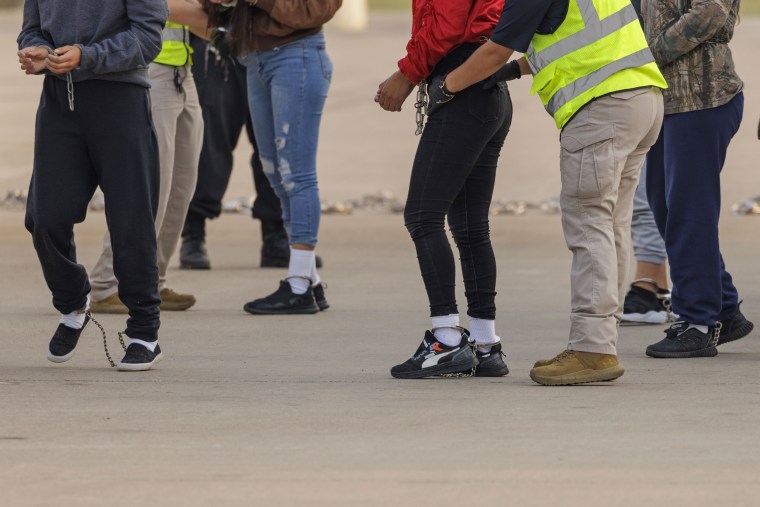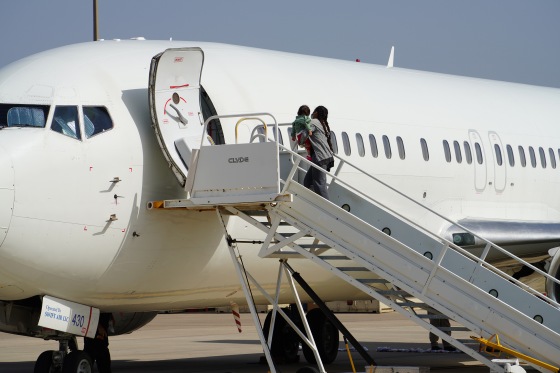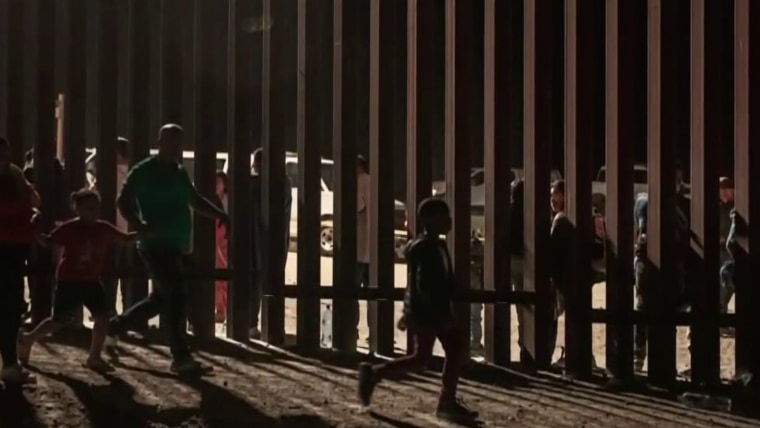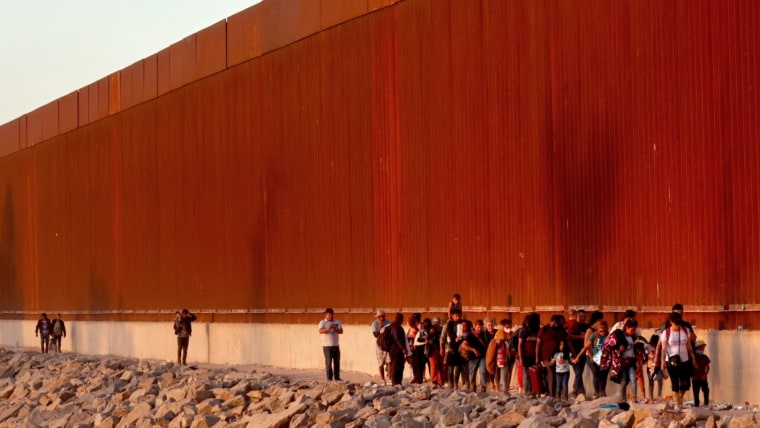Two former officials who handled immigration issues for then-President Donald Trump say that a “whole of government” approach costing billions would be needed to mount the “largest deportation effort in American history” promised in the Republican convention platform if Trump is re-elected.
The exact number of people who would be deported in a second Trump administration is hard to pin down.
During the June 29 presidential debate, Trump claimed there were 18 million undocumented immigrants in the U.S. One of the two former Trump officials said it could be as high as 30 million.
The most recent government estimate is that just under 11 million unauthorized immigrants resided in the U.S. as of Jan. 1, 2022, up 500,000 from two years earlier but down from the 2010 total of 11.6 million.
It’s unclear how many more noncitizens have entered the U.S., or have changed their legal status or left voluntarily since that estimate.

Whatever the current total of undocumented immigrants, deportation efforts during both the Trump and Biden administrations have been just a tiny fraction of what the Republican National Convention platform promises for a second Trump presidency.During the Trump years there were an estimated 935,089 deportations, according to Immigration and Customs Enforcement data. As of February, there have been an estimated 339,751 deportations during the Biden administration.
Last week, according to Semafor, a former acting ICE director under Trump who is seen as a possible Department of Homeland Security chief in a second Trump administration told a conservative conference, “They ain’t seen s--- yet. Wait until 2025.”
“Trump comes back in January,” Tom Homan said, “I’ll be on his heels coming back, and I will run the biggest deportation force this country has ever seen.”
In a statement, Trump campaign Trump national press secretary Karoline Leavitt said, "A majority of Americans want mass deportations for illegal immigrants. ... On Day One back in the White House, President Trump will begin the largest criminal deportation operation of illegal immigrants and restore the rule of law.”
‘Astronomical’
NBC News asked acting ICE Director Patrick J. Lechleitner about what would be required to deport millions of people.
Lechleitner was not commenting on the Republican convention platform but said in general deportation is very complicated and requires an enormous amount of logistics: “It’s not only putting them on planes and flying them, which is expensive, we got to have airplanes. We also have to deal with host nations. We have to get travel documents, we have to do all the logistics involved with that.”
He said for some people who are not in detention, the path to deportation can take years. “We have to monitor them that whole time. That’s resource intensive,” he said.
Abigail Andrews, a professor of urban studies and planning at the University of California, San Diego who has been studying deportation data for the past 10 years, said she’s highly skeptical about how a mass deportation effort would unfold.
“There is no logistical way to track down 10 to 12 million undocumented immigrants with the ICE employees they currently have,” she said.
She said the vast majority of deportees are not arrested in their homes by ICE agents but have had some interaction with local law enforcement, like a traffic stop, that leads them eventually into ICE custody.Andrews said efforts undertaken by ICE to hunt down criminals in neighborhoods are traditionally reserved for those who are convicted or suspected of serious violent crimes. And she noted that research has established that immigrants commit less crime than average Americans.
Ammon Blair, a former Border Patrol agent who left the agency in 2023 and is now a senior fellow at the Texas Public Policy Foundation, also expressed skepticism. "I honestly just don’t see it happening," he said. "One, because I think it’s political suicide, and two, I think we need to focus on national security issues."
Blair said an effort of the size proposed would require heavy involvement from local law enforcement — and he said border cities are already handling enough. "We don’t have the manpower or space to handle," he said. "The federal spending would have to flow to these local agencies." He also said the optics of deporting children could create significant backlash.
Mark Morgan, former acting commissioner of Customs and Border Protection under Trump, said mass deportations should prioritize those who have committed serious crimes rather than families. He said enforcement could be via additional funding to ICE as well as consequences for cities that refuse to cooperate.
“One thing I think we need to do is go after the sanctuary cities to take away their funding,” said Morgan, now a visiting fellow at the Heritage Foundation, a conservative think tank.Experts say costs would quickly mount with an operation of this size.
The ICE budget for transportation and deportation in 2023 was $420 million, and in that year the agency deported 142,580 people. Costs of deportation vary widely depending on the country and include variables such as commercial flight costs, security needs and the use of charter flights. Removal of 10 million people could easily cost in the tens of billions.
But the millions of deportees would also have to be detained and housed prior to removal. Currently ICE manages 41,500 beds across 200 jail and detention centers at a cost of $57,378 per year per bed, according to public budget documents. In the event of a mass deportation, the government would need to pay for far more beds.
The combined cost, Andrews said, “would be astronomical.”
Those who support a mass deportation say the cost to detain and remove undocumented immigrants is worth it because of the significant cost savings related to education and health care spending on undocumented communities.
As for families with mixed status such as those with children who are citizens and parents who are undocumented, one of the former Trump officials sees it as an opportunity, hoping that the threat of removing one member will propel whole families to leave. “Your parents can’t use you as a prop to justify their illegal presence,” the former official said.
The former Trump officials said cooperation across the entire federal government, not just from DHS leadership, would be needed.
One of the ex-officials said the effort would require a “trigger puller,” someone at DHS who would not be afraid to go in front of Congress and defend the deportation effort.
The former Trump officials said buy-in and resources would be needed from agencies like the Pentagon, which would be asked to participate in either setting up detention camps or relocating migrants to foreign military bases. The Interior Department would be called upon because federal land might be needed for deportation sites. They said cooperation from the Justice Department and the Drug Enforcement Administration, as well as from the Department of Health and Human Services, which oversees the care and custody of unaccompanied children, would also be required to facilitate removals.
Mario Russell, executive director of the Center for Migration Studies, a think tank that advocates for immigrant rights, agrees that deporting millions of people would require all aspects of government. “But it would be folly and absurdly expensive and counterproductive, not to mention profoundly cruel,” he said.His team estimates that about 50% of the nation’s undocumented population are actually people who overstayed their visas. He said others might have “Dreamer” status, temporary worker status or are working their way through the asylum system.
He also said his group prepared for a similar mass deportation scenario prior to Trump’s inauguration in 2017 and no removal of millions of immigrants materialized. “One is left to wonder if it’s more talk than threat,” he said.






